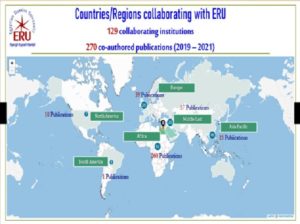According to the journals of the international "Scopus" platform, the Egyptian Russian University reveals the harvest of its faculties' scientific research
Dr. Sherif Fakhry, President of the Egyptian Russian University, stated that the faculties members at the university published 150 distinguished research papers within the internationally indexed journals on the international “Scopus” platform. The number of researches has witnessed an increase of 78% compared to what was published in 2020. He Noted that the scientific publication year ends in the middle of the following year. The 2021 researches recorded 799 citations and Hirsch coefficient was H-index 14. It is worth mentioning that the total scientific publication of the Egyptian Russian University has reached 677 researches including 199 researches that were published in 2022.
Upon analysing this data, it was shown that the researches published in 2021 were in the fields of Chemistry, Engineering, Pharmacology, Toxicology and Medicine, Medicine, Biochemistry, Genetics, Molecular Biology, Materials science, Physics and Astronomy, and Computer Science. Moreover, Dr Sherif Fakhry clarified that the university took part in publishing international researches with Cairo University, Al-Azhar University, Minia University, Zagazig University, Helwan University, Ain Shams University, Menoufia University and Badr University in Cairo, besides a number of other universities. By analyzing the researches published in 2021, it was found that there is a clear international cooperation in conducting these researches and that the most country that participated with the university in publishing is the Kingdom of Saudi Arabia, followed by the United States of America, then China, Iran, the United Kingdom, Italy, Czechoslovakia, Germany, Japan, Russia, Spain, United Arab Emirates and others.
For his part, Dr. Essam Khamis, Vice President of the Egyptian Russian University, elaborated that the detailed analysis of the university’s outputs from the researches published during a short-term strategic period 2019-2021, using the two international platforms Scopus & Scival, showed that the number of researches reached 284 research papers during that time, and the average number of citations for each research reached 8.5 citations, Hirsch coefficient became H-index 29, and the Field-Weighted Citation Impact of the university was 1.29, which is higher than the global average in all disciplines at a rate of 29%. In addition, 42.2% of these researches are published in the top 25% researches of the list of indexed journals globally, and 27.1% are published in the top from 25% to 50% researches of the list of indexed journals. This researches covered nine United Nations Sustainable Development Goals (SDGs): Goal 2 (zero hunger), Goal 3 (good health and well-being), Goal 6 (clean water and sanitation), and Goal 7 (clean and affordable energy), Goal 8 (decent work and economic growth), Goal 9 (industry, innovation and infrastructure), Goal 11 (sustainable cities and communities), Goal 12 (sustainable consumption and production patterns), and Goal 15 (wildlife). Dr. Essam Khamis stated that the percentage of university researches published in 1% and 10% of the highest journal list amounted to 16.7% of the total publication during that period.
The vice president of the university pointed at the fact that the joint international cooperation l with 129 international universities and research institutions has amounted to 35.6% of the total publication and that the average number of citations for each research of them amounted to 14.9 citations, and the field weighted citation impact in the university rose to 2.18, while the scientific cooperation with companies and beneficiaries increased to 1.1%, the average number of citations for each research amounted to 6.7 citations and the field weighted citation impact
In university reached 1.12.
Within the framework of the university’s endeavor to reflect Its potential in all international scientific forums and classifications, the university is working with its faculties members to increase the scientific publishing in internationally indexed journals, especially the journals included in the top 25% of the list of those journals (Q1), and to increase citations for published researches their field weight.









